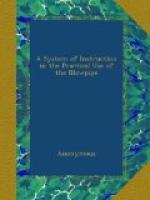(f.) Pelopic Acid (PeO^{3}).—This acid is white, and appears yellow when heated, but resumes its white color when cold. Borax dissolves it in the oxidation flame to a clear colorless bead, which appears, when overcharged and heated intermittingly, enamel-white when cold. This is likewise the case in the flame of reduction, but when overcharged the color is light grey, when the bead is cooled.
Microcosmic salt dissolves it in the flame of oxidation, to a clear yellow bead, which loses its color when cold. In the reduction flame, when the bead is highly saturated, a violet-brown color is produced. In presence of the oxides of iron, the reactions are like those of niobic acid. With carbonate of soda, the reactions are similar to those of niobic acid. By heating with nitrate of cobalt, it yields a light grey infusible mass.
(g.) Titanium (Ti).—This metal occurs occasionally in the slags of iron works, in the metallic state, as small cubical crystals of a red color. It is a very hard metal, and very infusible. Titanic acid occurs in nature crystallized in anatase, arkansite, brookite, and rutile. Titanium is harder than agate, entirely infusible, and loses only a little of its lustre, which can be regained by fusion with borax. It does not melt with carbonate of soda, borax, or microcosmic salt, and is insoluble in every acid except the hydrofluoric. By ignition with saltpetre it is converted into titanic acid, which combines with the potassium, forming the titanate of potassium.
Titanic Acid (TiO^{2}) is white, insoluble, and, when heated, it appears yellow while hot, but resumes upon cooling its white color.
Borax dissolves it in the oxidation flame to a clear yellow bead, which when cool is colorless. When overcharged, or heated with the intermitting flame, it is enamel-white after being cooled. In the reduction flame, the bead appears yellow, if the acid exists in small quantity, but if more be added, then it is of an orange, or dark yellow, or even brown. The saturated bead, when heated intermittingly, appears when cold of an enamelled blue. By addition of the acid, and by heating the bead on charcoal in the reduction flame, it becomes dark yellow while hot, but dark blue, or black and opaque when cold. This bead appears, when heated intermittingly, of a light blue, and when cold, enamelled.
Microcosmic salt fuses with it in the oxidation flame to a clear colorless bead, which appears yellow only in the presence of a quantity of titanic acid, though by cooling it loses its color. In the reduction flame this bead exhibits a yellow color when hot, but is red while cooling, and when cold of a beautiful bluish-violet. If the bead is overcharged, the color becomes so dark that the bead appears opaque, though not presenting an enamel appearance. By heating the bead again in the oxidation flame the color disappears. The addition of some tin promotes the reduction. If the titanic acid contains oxide of iron, or if some is added, the bead appears, when cold, brownish-yellow, or brownish-red.




